Baseball Skills - Pitching Elements
The best method for learning Baseball Skills is the basic Building Block method, which simply means building one skill on top of another just as a child stacks blocks on top of one another.
Let’s look at a few basic Skills for Pitchers.
Drop Step: - Confusion
As a pitcher goes into his motion, he takes a “Drop Step,” which is the first step he takes and is taken backwards, as he puts his body into motion. There is a lot of confusion regarding the drop step and it’s true purpose.
(1.) A large (long) stride backwards serves no purpose except to throw the body Off Balance, which is a critical error in pitching, and most other skilled moves, such as hitting. Balance is not important … it’s Imperative.
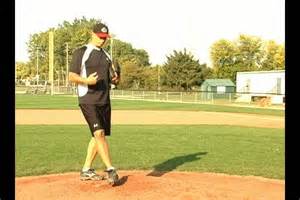
Simple Rock Backwards
(a.) Some think the long back step is required to increase the force the body uses to explode towards the plate, thus increasing velocity of the ball. This is a falsehood.
(2.) The true purpose of the Drop Step is to shift the body weight to the back foot, in order to turn the drive foot sideways against the pitching rubber.
(a.) A short, controlled drop step should be utilized, which will allow the pitcher to maintain control and balance.
Baseball Skills: Push Off and Landing
Similar to the long drop step, an overextended & long stride can have a negative affect on your balance and control. The idea that by using a long stride, which brings you closer to the plate, making your pitches appear to have more velocity, is not necessarily true.
A 6’ 8” pitcher will land closer to the plate, thus quicker to the batter, than a 5’ 7” pitcher, but this is due to the natural stride and stature difference between the two pitchers, not because of an intentional overextended stride.
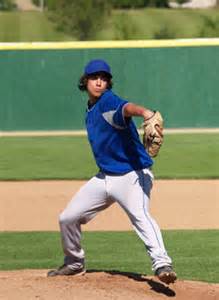
Baseball Skills - Strong Push Off
(1.) A pitcher should pitch Ball of Foot to Ball of Foot.
(a.) You should be on the ball of your rear foot when pushing off the rubber
(b.) You should land on the Ball of your Foot with your front foot.
(c.) To land on your heel creates a balance problem, which will tend to pull you sideways off the mound, left side for a right handed pitcher, right side for a lefty, which creates a Control Problem.
Baseball Skills: Preparing to Pitch
Consistency is a word you’ll hear a lot in baseball, as it’s a large key to success. Find what works the best for you, whether pitching, hitting or fielding and perform that skill in a consistent manner and success usually quickly follows.
When preparing your delivery, you should have a consistent pattern or routine between or prior to every pitch. This routine can vary between each pitcher from walking around the mound, to spitting a sun flower seed, to whatever, but they’ll perform their little ritual every time.
(a.) The most important thing a routine is designed to accomplish is …. Allowing the pitcher to Relax and Focus.
(b.) Stand comfortably on the rubber squarely facing the catcher ….
(c.) There’s No need to bend over or use any other exaggerated stance, unless it’s more comfortable for you.
(d.) As you take the signals from the catcher you do NOT …Think of how hard you’re going to throw the fastball or how much break you’re going to have on your curveball, or your grip on the ball.
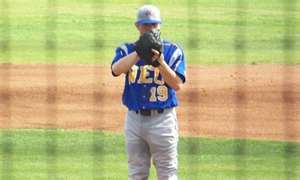
Baseball Skills - Relaxed Concentration
(e.) Think only Location ! muscle memory and repetitive practice throwing the particular pitch will automatically occur, based on proper mechanics, but location changes on every batter or situation.
Baseball Skills - Staying on Top
You’ll hear coaches tell their pitchers to “stay on top of the ball,” but what does that mean?
(1.) All pitches are designed to move, sink, sail etc because of the Grip of the ball, which combined with other physical movements, dictates movement, velocity and control.
(2.) It’s important to maintain the same release point, arm motion and power down through the pitch for maximum effectiveness.
(3.) Some pitchers will alter their arm angle, bringing it away from their head, with the intentions of changing the rotation, thus the ball’s reaction, of the same pitch. This, in fact does happen, but a lot of times with undesired results, as the control suffers and the ball will have a tendency to sail.
(4.) The best method for insuring staying on top of the ball is to complete your follow through by reaching for your hip, opposite your pitching arm. If your arm angle is too far away from your head or angled too much, reaching your hip is quite difficult.
You’ll be able to swing your arm past the hip, but not directly to it, which is an indication you’re not on top of the ball.
Baseball Skills - Fielding
We tend to forget the pitcher is also an infielder, responsible for fielding his position and knowing how to fulfill their responsibilities during other plays occurring in the infield and outfield.
Let’s exam one of these responsibilities.
The pitcher must be trained to instinctively run towards first base on any ball hit to the Right side of the infield.
When the ball is initially hit, the pitcher has no idea where the ball is going, except to the right side, and if or who will be able to field it, therefore his job to cover first base and receive a throw from the infielder, whether the first or second baseman.
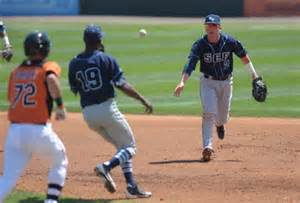
Baseball Skills - Flip From 1st Baseman to Pitcher
He should automatically assume the first baseman will field the ball and will not be able to beat the runner to the base, and
since he is trying to beat the runner, who is running as fast as possible in order to be safe, he doesn't have the luxury of waiting to see what happens. He must act immediately.
Naturally, as soon as he sees it’s a routine 2nd to 1st put out, he pulls up, but on balls fielded by the first baseman,especially to his far right, and even some fielded by the second baseman if the ball splits the two infield positions, the pitcher has to receive the throw at first in order to get the hitter out.
How does he do this? There are two methods taught for this play.
Method one: The pitcher runs as hard as he can to a predetermined spot along the baseline @ 5-6 feet in front of first base, then veers up the baseline in the same direction and method as if he were the base runner.
He is looking at the fielder who has the ball, who is clearly showing the ball to the pitcher by holding it out away from his body. He then throws a chest high strike to the pitcher, who receives the ball and steps on the base.
This is not the preferred method because technically the pitcher will be running a longer distance to first, but I taught this method because I was coaching younger players and the fielders seemed better capable of judging the Lead of the throw to the pitcher when he was running directly down the baseline.
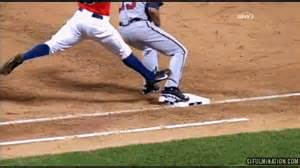
Baseball Skills - Possible Severe Injury
Method Two The pitcher runs a Direct straight line to the first base bag. Again, the fielder, while clearly showing the pitcher the ball, throws a chest high strike to the pitcher, who receives the throw and steps on the base.
The reasoning behind this method is simple “ Closest point between point A & B is a straight line. The pitcher reaches first base as quickly as humanly possible.
Either method is correct. You as a coach must determine if the split second quicker to first base by using the direct method is important enough to over ride the easier “lead” throw for the fielder. The age and skill levels of your players will have a direct affect on which method you teach.
There are Two matters which are identical in either Baseball Pitching method.
One, the pitcher must be careful to NOT enter the runner’s portion of the baseline and restrict the runner, in any way, of his forward movement and speed. This would be considered interference and the runner would be declared Safe no matter the ball beating him to the base or not.
The Second, and most important matter is to "Never Step Directly On The Base!
The pitcher should step on the infield side of the base only, preferably hitting the side of the base with most of your foot off the base. To have your foot on the base presents a severe danger of having the runner step on your ankle, or the two players tripping one another.
Either situation is dangerous and could result in severe injury to either or both players.
It’s important to record the out, but it’s also important to do it as safely as possible so you can return to the mound to continue pitching.
Baseball Skills Back to Learn to Pitch

New! Comments
Have your say about what you just read! Leave me a comment in the box below.